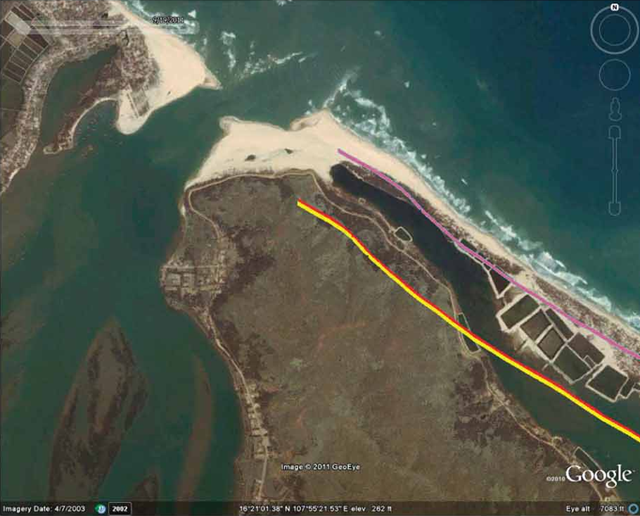

| Visitors Now: | |
| Total Visits: | |
| Total Stories: |

| Story Views | |
| Now: | |
| Last Hour: | |
| Last 24 Hours: | |
| Total: | |
Coastline erosion due to sea level rise greater than previously thought: new study
4 September 2012 (PhysOrg) – A new model allows researchers at UNESCO-IHE, Delft University of Technology and Deltares to much more accurately predict coastline erosion due to rising sea levels. It would appear that the effects of coastline erosion as a result of rising sea-level rise in the vicinity of inlets, such as river estuaries, have until now been dramatically underestimated. The scientists have published their research in the online edition of Nature Climate Change on 2 September 2012.
The anticipated rise in sea levels due to climate change will result in coastlines receding worldwide through erosion. This is a known phenomenon that can in principle be calculated and predicted based on a given sea-level rise, by means of the so-called Bruun effect. However, things are a little more complicated when it comes to coastlines in the vicinity of inlets, such as river mouths, lagoons, and estuaries. These places are affected by other factors, such as changes in rainfall due to climate change, and certain compensating effects (basin infilling).
Until now, science has lacked a model that takes all these effects into account in the calculations of a coastline’s future development, even though a demand for this existed among engineers, coastal managers and planners. The majority of coastline prognoses only took the Bruun effect into consideration.
Scientist Rosh Ranasinghe, employed as associate professor at TU Delft and at UNESCO-IHE, has now succeeded in developing a new model that is able to produce much more accurate prognoses. He did so together with researchers of the faculty of Civil Engineering and Geosciences at TU Delft, UNESCO-IHE and knowledge institution Deltares. With the model, it is possible to make accurate predictions quickly – within a few minutes – of how the coastline will develop in the vicinity of inlets as a result of rising sea-levels.
The new model was in turn applied to four different and representative coastal areas (in Vietnam and Australia). The research showed that only 25 to 50 per cent of anticipated coastline change in these areas can be predicted using the Bruun effect. The other processes that occur in the vicinity of inlets are of at least equal importance and coastline change in these areas as a result of rising sea levels has until now been strongly underestimated.
This new model makes it possible to make significantly improved prognoses of coastline erosion due to a rise in sea-levels. Coastal management projects that are being launched shortly will be able to benefit from this model, which means it can make a valuable contribution to coastal management and planning in practice.
New model: Coastline erosion due to sea level rise greater than previously thought
2012-09-06 20:16:03
Source: http://www.desdemonadespair.net/2012/09/coastline-erosion-due-to-sea-level-rise.html
Source:



